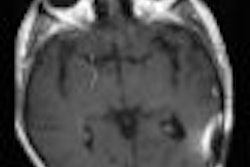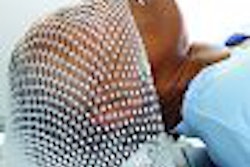
The downside to breast IMRT is that adjacent organs can receive larger volumes of low-dose radiation than they would with conventional radiotherapy. U.S. researchers have now devised a beam arrangement that delivers the benefits of IMRT, but without upping the low-dose overspill (Medical Dosimetry, Spring 2008, Vol. 33:1, pp. 71-77).
Using IMRT instead of 3D conformal radiation therapy can double the incidence of radiation-induced malignancies in long-term survivors of breast cancer, according to Raef Ahmed and colleagues from the Birmingham Comprehensive Cancer Center at the University of Alabama in Birmingham. This was due "to a combination of the increase in monitor units and the increased low-dose distribution from the use of multiple fields," they said.
The researchers prepared IMRT plans for five patients with early-stage left-sided breast cancer who had already undergone breast-conserving surgery and conventional radiation treatment. The target volume and at-risk structures were identified on CT images acquired with 3-mm slice thickness. Each IMRT plan was designed to deliver 45 Gy in 1.8 Gy fractions to an isocenter near the center of the left breast, just as the patients' conventional radiotherapy treatment had been.
It's all about delivery
The team's chosen setup used six tangential treatment beams (three medial and three lateral). Heavily weighted cost functions were used to reduce beamlet intensities through the lungs, heart, and contralateral breast. Optimization parameters were selected so that the dose delivered to at-risk organs would be less than that delivered via the conventional treatment plan, but without compromising coverage of the left breast.
A comparison of dose-volume histograms revealed that these IMRT plans provided better coverage of the left breast than the corresponding conventional radiotherapy plans. Surprisingly, the dose heterogeneity was also higher for the IMRT plans, though the difference was not statistically significant.
"This increase in heterogeneity could be explained by our optimization parameters attempting to spare risk organs at very low doses," Ahmed and colleagues stated.
The mean volume of heart irradiated during treatment decreased using the IMRT plans. This reduction was only significant for regions affected by the lowest level of overspill (2.25 Gy, or 5% of the total treatment dose). Switching to IMRT reduced the mean volume of the heart that received this radiation dose from 32% to 19%.
In the lung, the mean volume of tissue affected by dose overspill was also reduced. However, in this case, the difference was significant for volumes receiving higher doses of radiation (95%, 85%, 80%, and 75% of total treatment dose) as well as smaller doses (5%, 10%, and 15%). As before, the IMRT technique was most effective at sparing tissue from the lower levels of radiation.
The most impressive reduction in overspill was observed in the right breast. Here, switching from a conventional radiation-therapy plan to the corresponding IMRT plan cut the mean volume of tissue irradiated at all dose levels (5% to 100% of treatment dose).
The results confirm the viability of this IMRT planning approach for sparing healthy structures from small, but significant, levels of radiation. "This study demonstrated that a six-tangential-field IMRT significantly reduced dose to the heart, lung, and contralateral breast, even at lower dose levels, and therefore may potentially decrease the risk of radiation-induced secondary malignancies," the researchers concluded.
By Paula Gould
Medicalphysicsweb contributing editor
March 3, 2008
Related Reading
Good vibrations stave off blood-borne diseases, February 11, 2008
Toxicity levels with gynecologic chemoradiation deemed acceptable, November 28, 2007
Cell survival offers IMRT insight on 'bystander effect,' November 23, 2007
Lung function guides IMRT planning, October 24, 2007
© IOP Publishing Limited. Republished with permission from medicalphysicsweb, a community Web site covering fundamental research and emerging technologies in medical imaging and radiation therapy.



















